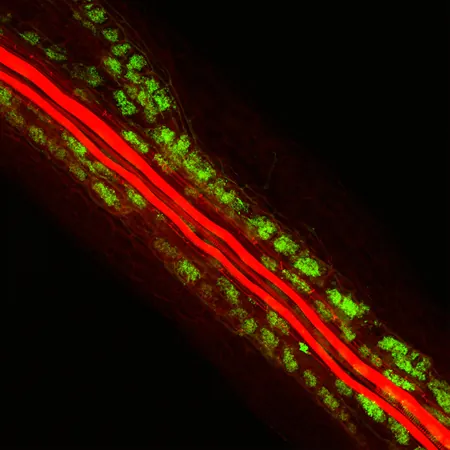
Unlocking Nature's Secrets: How Peptides Are Revolutionizing Farming
2025-04-14
Author: Yu
Revolutionizing Agriculture with Science
Industrial farming has pushed soil health to the brink with the skyrocketing use of artificial fertilizers—up more than four times since the 1960s! But what if there was a natural way to revitalize our crops without the environmental toll of chemicals? Enter the groundbreaking research from the Salk Institute, where scientists are harnessing the power of small peptides to foster a better partnership between plants and fungi.
The Power of Symbiosis: A Natural Solution
In an exciting new study, Salk researchers have discovered a key player in plant-fungi cooperation: a tiny peptide named CLE16. This molecular hero encourages root systems to connect with beneficial soil fungi, creating a natural ecosystem where fungi deliver essential nutrients to plants. By boosting this symbiotic relationship, we may finally reduce our reliance on harmful fertilizers!
The Science Behind the Discovery
Published on April 14, 2025, in The Proceedings of the National Academy of Sciences, the study reveals that significant agricultural advancements over years have weakened crop resilience to natural partners like fungi. As lead researcher Lena Mueller states, 'We've forgotten how to let nature help us.' By replenishing these essential traits, farms could flourish without synthetic additives.
How It Works: The Magic of CLE16
Through experiments with the Mediterranean legume Medicago truncatula, researchers observed that as the plant engaged with fungi, it began producing high levels of CLE16. Previously, scientists mainly studied CLE peptides as antagonists to symbiosis. This breakthrough could pave the way for a more diverse, eco-friendly agricultural system.
Proof in the Petri Dish
To prove CLE16's efficacy, the team enriched the soil with this peptide and witnessed a remarkable increase in fungal structures thriving in the plant roots. Not only did the fungi flourish, but they also enhanced targeted nutrient exchange—creating a self-reinforcing cycle of growth and sustainability in agriculture.
Future Prospects: A Green Revolution?
This research shines a light on an innovative future for farming. It’s not just about replacing fertilizers. By applying similar methods to other vital crops—like soy, corn, and wheat—farmers could cultivate bountiful yields while preserving soil health. Mueller highlights how beneficial fungi can serve as natural fertilizers and protect plants, reducing our dependency on harmful pesticides.
A Sustainable Path Forward
With the potential to transform our farming practices and tackle pressing environmental issues, the path to sustainable agriculture could lie in the very fibers of nature. With ongoing support and more research, we are on the verge of a new agricultural era—one where plants, fungi, and farmers all thrive together!

 Brasil (PT)
Brasil (PT)
 Canada (EN)
Canada (EN)
 Chile (ES)
Chile (ES)
 Česko (CS)
Česko (CS)
 대한민국 (KO)
대한민국 (KO)
 España (ES)
España (ES)
 France (FR)
France (FR)
 Hong Kong (EN)
Hong Kong (EN)
 Italia (IT)
Italia (IT)
 日本 (JA)
日本 (JA)
 Magyarország (HU)
Magyarország (HU)
 Norge (NO)
Norge (NO)
 Polska (PL)
Polska (PL)
 Schweiz (DE)
Schweiz (DE)
 Singapore (EN)
Singapore (EN)
 Sverige (SV)
Sverige (SV)
 Suomi (FI)
Suomi (FI)
 Türkiye (TR)
Türkiye (TR)
 الإمارات العربية المتحدة (AR)
الإمارات العربية المتحدة (AR)